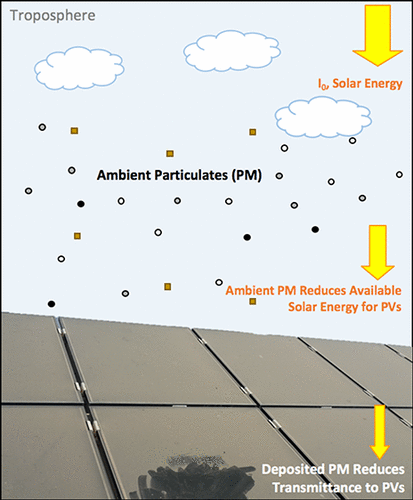当前位置:
X-MOL 学术
›
Environ. Sci. Technol. Lett.
›
论文详情
Our official English website, www.x-mol.net, welcomes your
feedback! (Note: you will need to create a separate account there.)
Large Reductions in Solar Energy Production Due to Dust and Particulate Air Pollution
Environmental Science & Technology Letters ( IF 8.9 ) Pub Date : 2017-06-29 00:00:00 , DOI: 10.1021/acs.estlett.7b00197 Mike H. Bergin 1 , Chinmay Ghoroi 2 , Deepa Dixit 2 , James J. Schauer 3 , Drew T. Shindell 4
Environmental Science & Technology Letters ( IF 8.9 ) Pub Date : 2017-06-29 00:00:00 , DOI: 10.1021/acs.estlett.7b00197 Mike H. Bergin 1 , Chinmay Ghoroi 2 , Deepa Dixit 2 , James J. Schauer 3 , Drew T. Shindell 4
Affiliation

|
Atmospheric particulate matter (PM) has the potential to diminish solar energy production by direct and indirect radiative forcing as well as by being deposited on solar panel surfaces, thereby reducing solar energy transmittance to photovoltaics. Worldwide solar energy production is expected to increase more rapidly than any other energy source into the middle of this century, especially in regions that experience high levels of dust and/or anthropogenic particulate pollutants, including large areas of India, China, and the Arabian Peninsula. Here we combine field measurements and global modeling to estimate the influence of dust and PM related to anthropogenic sources (e.g., fossil and biomass fuel combustion) on solar electricity generation. Results indicate that solar energy production is currently reduced by ∼17–25% across these regions, with roughly equal contributions from ambient PM and PM deposited on photovoltaic surfaces. Reductions due to dust and anthropogenic PM are comparable in northern India, whereas over eastern China, anthropogenic PM dominates. On the basis of current solar generation capacity, PM is responsible for ∼1 and ∼11 GW of solar power reduction in India and China, respectively, underscoring the large role that PM plays in reducing solar power generation output.
更新日期:2017-07-12











































 京公网安备 11010802027423号
京公网安备 11010802027423号